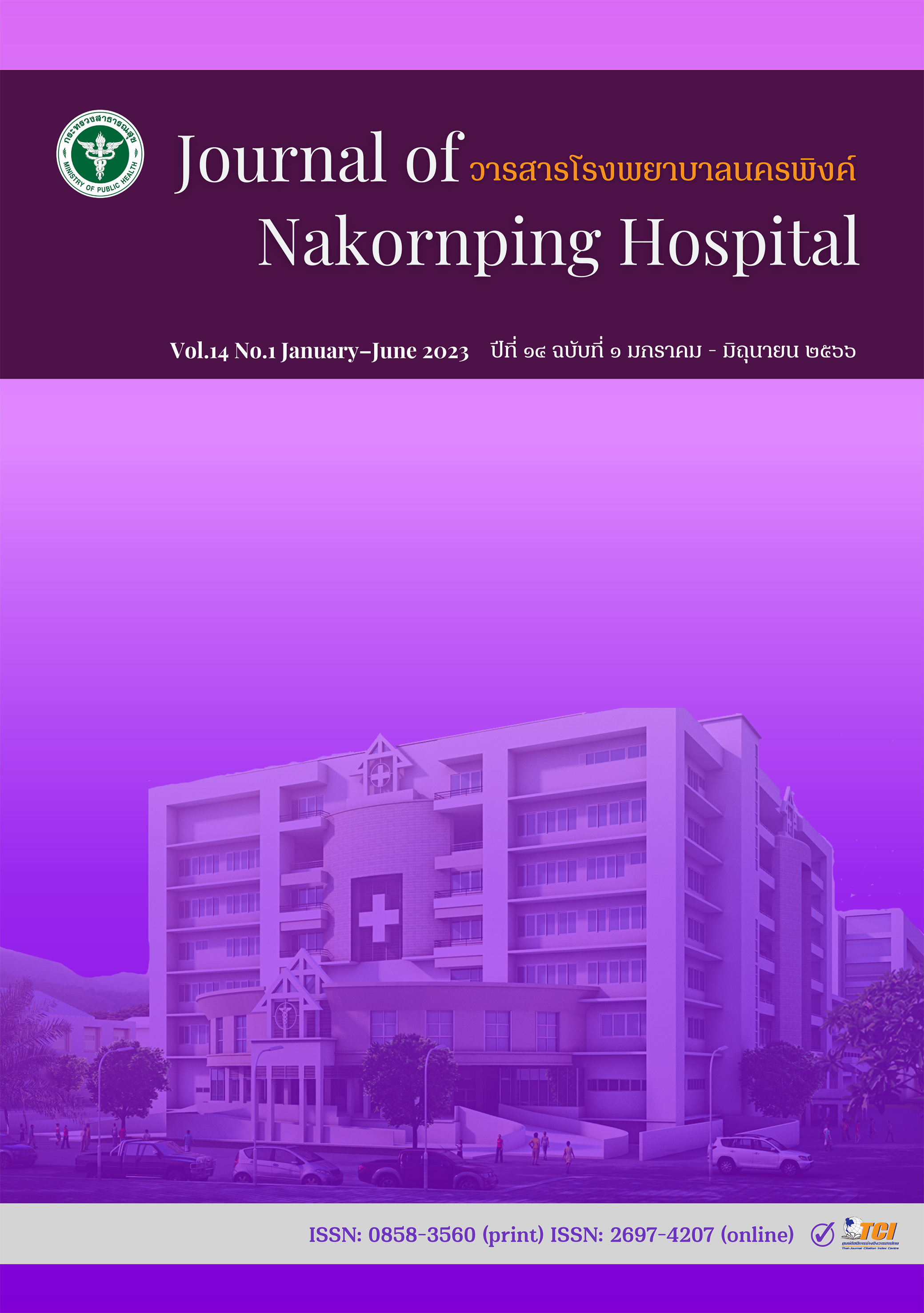The effects of promoting practical nursing while complying with pressure ulcer prevention guidelines, Male medical ward 2, Nakornping Hospital
Keywords:
Nursing practice promotion, pressure injury prevention, medical patientAbstract
Pressure ulcers are a significant and increasingly prevalent complication in tertiary hospitals, which have a profound impact on patients, resulting in distress and pain, increased risk of infection, prolonged hospitalization, and even mortality. While Nakornping Hospital has implemented preventive measures against pressure ulcers, there is still a lack of consistency and continuity. Thus, the researcher proposes an intervention to promote nursing practices based on pressure ulcer prevention guidelines in the male medical ward 2 of Nakornping Hospital. The objective of this study is to evaluate the effects of promoting nursing practices based on pressure ulcer prevention guidelines using a quasi-experimental pre- and post-test design. The study population consisted of 19 professional nurses and 132 patients at risk of developing pressure ulcers during September and December 2022. The data were analyzed using descriptive statistics, percentages, chi-square tests, and paired t-tests.
Results: The findings revealed that total 19 professional nurses enrolled in the study had the nurses' age ranged between 21 to 30 years, accounting for 68.42%. The majority of them were experienced professional nurses (89.47%). However, they had not received training specifically related to pressure ulcer prevention (84.21%). The comparison of nurses' knowledge before and after the intervention showed a statistically significant improvement (p-value < 0.001). Overall, the nurses expressed a high level of satisfaction with the promotion of nursing practices based on pressure ulcer prevention guidelines (94.74%). The patients or their caregivers also expressed a high level of satisfaction (96.21%). Moreover, there was a statistically significant difference in the incidence of pressure ulcers before and after the intervention (p-value = 0.024).
Conclusion: Based on the findings, it is evident that promoting pressure ulcer prevention nursing practices is essential in enhancing nurses' awareness and their ability to implement guidelines effectively, leading to a reduction in adverse effects on patients. Therefore, continuous support and promotion should be provided to ensure consistent adherence to these practices.
References
Dongpho P. Effectiveness of clinical practice guidelines implementation for pressure sore prevention. Thammasat Medical Journal. 2019;19(2):315-23. [In Thai]
Rungsangchan K, Sai-La W, Prasungsit J. Improving efficiency for caring patients: SSIET Bundle. Annual Meeting 2015 : Becoming a highly efficient organization; 2015 Dec 8-9; Faculty of Medicine Siriraj Hospital. Bangkok; 2015. Available from: https://www2.si.mahidol.ac.th/division/nursing/sins/download/meeting/sinsmeeting_2558_09.pdf [In Thai]
Wongtriratanachai P. Assessment of Pressure Ulcer and Benefit of Pressure Ulcer Treatment Following Clinical Practice Guideline. In: Muangman P. Wound Care 2013. Bangkok Medical Journal. 2013;209-21. [In Thai]
Alderden J, Rondinelli J, Pepper G, Cummins M, Whitney J. Risk factors for pressure injuries among critical care patients: A systematic review. Int J Nurs Stud. 2017;71:97-114. doi: 10.1016/j.ijnurstu.2017.03.012.
National Pressure Ulcer Advisory Panel, European Pressure Ulcer Advisory Panel, Pan Pacific Pressure Injury Alliance. Prevention and Treatment of Pressure Ulcers: Quick Reference Guide [Internet]. Australia: Cambridge Media; c2009 [cited 2016 March 12]. Available from: https://www.epuap.org/wp-content/uploads/2016/10/quick-reference-guide-digital-npuap-epuap-pppia-jan2016.pdf
Mamom J. The Nurses Role and Pressure Ulcers: Challenge in Prevention and Management. Thai Science and Technology Journal. 2012;20(5):4478-90. [In Thai]
Ministry of Public Health, Nursing Division. Guidelines for collecting indicators Improving the quality of nursing services Fiscal Year 2022. Nonthaburi: Nursing Division; 2022. p.37-40. Available from: http://49.231.188.70/Nursekhukhan/file/ebp/img_61f7c8f840f77.pdf [In Thai]
Nakornping Hospital. KPI Nursing department. Chiangmai: Nakornping Hospital; 2019-2021. [In Thai]
Nakornping Hospital, Nursing department. Assessment form practices for the prevention of pressure ulcer. Chiangmai: Nakornping Hospital; 2015. [In Thai]
Roger EM. Diffusion of Innovations. 4th ed. New York: Simon & Schuster; 1995.
Nakornping Hospital, Nursing department. Manual of pressure ulcer management. Chiangmai: Nakornping Hospital; 2015. [In Thai]
Ekakul T. Research methods in behavioral and social sciences. Ubon Ratchathani : Faculty of Education, Ubon Ratchathani Rajabhat Institute; 1999. [In Thai]
Health the region 1. ET Junior Nurse Project. Chiangmai: Health the region 1; 2020. [In Thai]
Siriraj Hospital, Nursing department. The Braden Scale for Predicting Pressure Sore Risk (Thai version). Bangkok: Siriraj Hospital; 2021. [In Thai]
Wongkeju P, Suwannakeeree W, Songthai N. Effects of Clinical Practice Guideline Use Promotion on Nurses, Practices and Catheter - Associated Urinary Tract Infections in Medical Intensive Care Unit. Journal of Nursing and Health Care. 2019;37(2):26-35. [In Thai]
Khangrang M, Soekphukhiao P. The results of promoting a program of evidence-based practice in nursing practice for knowledge and the practice of nurses in acute pain management for the newborn. Journal of Ratchathani Innovative Health Sciences. 2017;1(3):31-51. [In Thai]
Falanga V. Principles of Moist Wound Healing; 2000. [cited 2015 Sep 2]. Available from: http://www.southwesthealthline.ca/healthlibrary_docs/H.1.IntroMoistWoundHealing.pdf
Downloads
Published
How to Cite
Issue
Section
License
Copyright (c) 2023 Nakornping Hospital

This work is licensed under a Creative Commons Attribution-NonCommercial-NoDerivatives 4.0 International License.
The articles that had been published in the journal is copyright of Journal of Nakornping hospital, Chiang Mai.
Contents and comments in the articles in Journal of Nakornping hospital are at owner’s responsibilities that editor team may not totally agree with.



